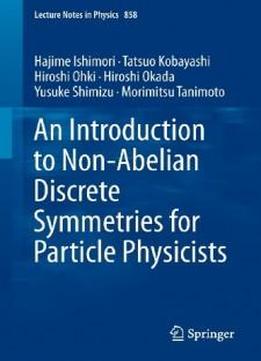
An Introduction To Non-abelian Discrete Symmetries For Particle Physicists (lecture Notes In Physics)
by Hajime Ishimori /
2012 / English / PDF
8.9 MB Download
These lecture notes provide a tutorial review of non-Abelian
discrete groups and show some applications to issues in physics
where discrete symmetries constitute an important principle for
model building in particle physics. While Abelian discrete
symmetries are often imposed in order to control couplings for
particle physics - in particular model building beyond the standard
model - non-Abelian discrete symmetries have been applied to
understand the three-generation flavor structure in particular.
Indeed, non-Abelian discrete symmetries are considered to be
the most attractive choice for the flavor sector: model builders
have tried to derive experimental values of quark and lepton
masses, and mixing angles by assuming non-Abelian discrete flavor
symmetries of quarks and leptons, yet, lepton mixing has already
been intensively discussed in this context, as well. The possible
origins of the non-Abelian discrete symmetry for flavors is another
topic of interest, as they can arise from an underlying theory -
e.g. the string theory or compactification via orbifolding –
thereby providing a possible bridge between the underlying theory
and the corresponding low-energy sector of particle physics.
This text explicitly introduces and studies the
group-theoretical aspects of many concrete groups and shows how to
derive conjugacy classes, characters, representations, and tensor
products for these groups (with a finite number) when algebraic
relations are given, thereby enabling readers to apply this to
other groups of interest.
These lecture notes provide a tutorial review of non-Abelian
discrete groups and show some applications to issues in physics
where discrete symmetries constitute an important principle for
model building in particle physics. While Abelian discrete
symmetries are often imposed in order to control couplings for
particle physics - in particular model building beyond the standard
model - non-Abelian discrete symmetries have been applied to
understand the three-generation flavor structure in particular.
Indeed, non-Abelian discrete symmetries are considered to be
the most attractive choice for the flavor sector: model builders
have tried to derive experimental values of quark and lepton
masses, and mixing angles by assuming non-Abelian discrete flavor
symmetries of quarks and leptons, yet, lepton mixing has already
been intensively discussed in this context, as well. The possible
origins of the non-Abelian discrete symmetry for flavors is another
topic of interest, as they can arise from an underlying theory -
e.g. the string theory or compactification via orbifolding –
thereby providing a possible bridge between the underlying theory
and the corresponding low-energy sector of particle physics.
This text explicitly introduces and studies the
group-theoretical aspects of many concrete groups and shows how to
derive conjugacy classes, characters, representations, and tensor
products for these groups (with a finite number) when algebraic
relations are given, thereby enabling readers to apply this to
other groups of interest.











